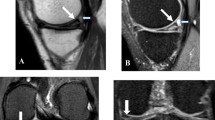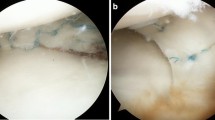Abstract
Objective
To prospectively evaluate the diagnostic accuracy of proton density-weighted imaging with and without fat suppression for detecting meniscal tears.
Materials and methods
The study involved 48 patients who underwent arthroscopy less than 3 months after proton density-weighted imaging with and without fat suppression. Sagittal images were independently reviewed by two radiologists for the presence of meniscal tears. Medial and lateral menisci were separately analyzed in terms of anterior horn, body, and posterior horn. Interobserver agreement was assessed using κ coefficients. The McNemar test was used to determine any differences between the two methods in terms of sensitivity and specificity. Arthroscopy findings were used as the diagnostic reference standard.
Results
Arthroscopy revealed 71 tears involving 85 meniscal segments: 34 medial meniscal segments and 51 lateral meniscal segments. The sensitivity, specificity, and accuracy of each radiologist were 95% (81/85), 92% (186/203), and 93% (267/288), and 93% (79/85), 93% (189/203), and 93% (268/288) when using fat-suppressed proton density-weighted imaging, and 91% (77/85), 93% (189/203), and 92% (266/288), and 91% (77/85), 93% (188/203), and 92% (265/288) when using proton density-weighted imaging without fat suppression, respectively. Interobserver agreement for meniscal tears was very high with proton-weighted imaging with (κ = 0.87) or without (κ = 0.86) fat suppression. There were no significant differences for detection of medial meniscal tears when using proton density-weighted imaging with or without fat suppression for both readers (p > 0.05).
Conclusion
Fat-suppressed proton density-weighted imaging can replace proton density-weighted imaging without fat suppression for the detection of meniscal tears.



Similar content being viewed by others
References
Escobedo EM, Hunter JC, Zink-Brody GC, Wilson AJ, Harrison SD, Fisher DJ. Usefulness of turbo spin-echo MR imaging in the evaluation of meniscal tears: comparison with a conventional spin-echo sequence. AJR Am J Roentgenol. 1996;167:1223–7.
Mirowitz SA, Apicella P, Reinus WR, Hammerman AM. MR imaging of bone marrow lesions: relative conspicuousness on T1-weighted, fat-suppressed T2-weighted, and STIR images. AJR Am J Roentgenol. 1994;162:215–21.
Lim PS, Schweitzer ME, Bhatia M, et al. Repeat tear of postoperative meniscus: potential MR imaging signs. Radiology. 1999;210:183–8.
Magee T, Shapiro M, Williams D. MR accuracy and arthroscopic incidence of meniscal radial tears. Skeletal Radiol. 2002;31:686–9.
Tarhan NC, Chung CB, Mohana-Borges AV, Hughes T, Resnick D. Meniscal tears: role of axial MRI alone and in combination with other imaging planes. AJR Am J Roentgenol. 2004;183:9–15.
Lee JH, Singh TT, Bolton G. Axial fat-saturated FSE imaging of knee: appearance of meniscal tears. Skeletal Radiol. 2002;31:384–95.
Schafer FK, Schafer PJ, Brossmann J, et al. Value of fat-suppressed proton-density-weighted turbo spin-echo sequences in detecting meniscal lesions: comparison with arthroscopy. Acta Radiol. 2006;47:385–90.
Jee WH, McCauley TR, Kim JM, et al. Meniscal tear configurations: categorization with MR imaging. AJR Am J Roentgenol. 2003;180:93–7.
Harper KW, Helms CA, Lambert 3rd HS, Higgins LD. Radial meniscal tears: significance, incidence, and MR appearance. AJR Am J Roentgenol. 2005;185:1429–34.
De Maeseneer M, Shahabpour M, Vanderdood K, Van Roy F, Osteaux M. Medial meniscocapsular separation: MR imaging criteria and diagnostic pitfalls. Eur J Radiol. 2002;41:242–52.
Noyes FR, Stabler CL. A system for grading articular cartilage lesions at arthroscopy. Am J Sports Med. 1989;17:505–13.
McGibbon CA, Trahan CA. Measurement accuracy of focal cartilage defects from MRI and correlation of MRI graded lesions with histology: a preliminary study. Osteoarthritis Cartilage. 2003;11:483–93.
Gold GE, Chen CA, Koo S, Hargreaves BA, Bangerter NK. Recent advances in MRI of articular cartilage. AJR Am J Roentgenol. 2009;193:628–38.
Sonin AH, Pensy RA, Mulligan ME, Hatem S. Grading articular cartilage of the knee using fast spin-echo proton density-weighted MR imaging without fat suppression. Am J Roentgenol. 2002;179:1159–566.
Crewson PE. Reader agreement studies. AJR Am J Roentgenol. 2005;184:1391–7.
Delfaut EM, Beltran J, Johnson G, Rousseau J, Marchandise X, Cotton A. Fat suppression in MR imaging: techniques and pitfalls. Radiographics. 1999;19:373–82.
De Maeseneer M, Shahabpour M, Vanderdood K, Van Roy F, Osteaux M. Medial meniscocapsular separation: MR imaging criteria and diagnostic pitfalls. Eur J Radiol. 2002;41:242–52.
Rubin DA, Britton CA, Towers JD, Harner CD. Are MR imaging signs of meniscocapsular separation valid? Radiology. 1996;201:829–36.
Yoshioka H, Stevens K, Hargreaves BA, et al. Magnetic resonance imaging of articular cartilage of the knee: comparison between fat-suppressed three-dimensional SPGR imaging, fat-suppressed FSE imaging, and fat-suppressed three-dimensional DEFT imaging, and correlation with arthroscopy. J Mag Reson Imaging. 2004;20:857–64.
Potter HG, Linklater JM, Allen AA, Hannafin JA, Haas SB. Magnetic resonance imaging of articular cartilage in the knee. An evaluation with use of fast-spin-echo imaging. J Bone Joint Surg Am. 1998;80:1276–84.
Mohr A. The value of water-excitation 3D FLASH and fat-saturated PDw TSE MR imaging for detecting and grading articular cartilage lesions of the knee. Skeletal Radiol. 2003;32:396–402.
Saadat E, Jobke B, Chu B, et al. Diagnostic performance of in vivo 3-T MRI for articular cartilage abnormalities in human osteoarthritic knees using histology as standard of reference. Eur Radiol. 2008;18:2292–302.
Sonin AH, Pensy RA, Mulligan ME, Hatem S. Grading articular cartilage of the knee using fast spin-echo proton density-weighted MR imaging without fat suppression. AJR Am J Roentgenol. 2002;179:1159–66.
Gagliardi JA, Chung EM, Chandnani VP, et al. Detection and staging of chondromalacia patellae: relative efficacies of conventional MR imaging, MR arthrography, and CT arthrography. AJR Am J Roentgenol. 1994;163:629–36.
Acknowledgements of funding and grants
Nothing to disclose.
Author information
Authors and Affiliations
Corresponding author
Rights and permissions
About this article
Cite this article
Lee, SY., Jee, WH., Kim, S.K. et al. Proton density-weighted MR imaging of the knee: fat suppression versus without fat suppression. Skeletal Radiol 40, 189–195 (2011). https://doi.org/10.1007/s00256-010-0969-2
Received:
Revised:
Accepted:
Published:
Issue Date:
DOI: https://doi.org/10.1007/s00256-010-0969-2




